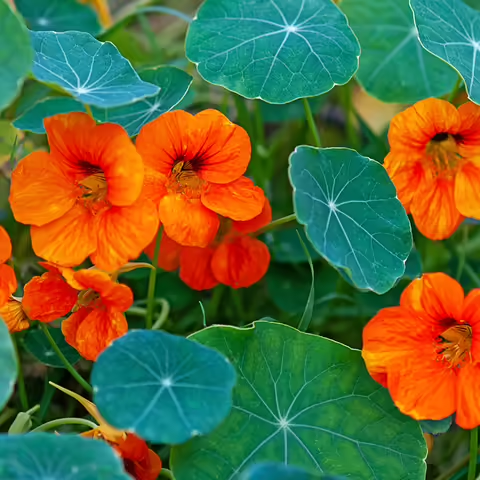Nasturtium
Tropaeolum sp.
Nasturtium is both a decorative garden annual as well as a useful culinary herb. There are two types of nasturtium; a trailing type (Tropaeolum majus) that can be trained to climb or allowed to spread on the ground and a bush type (Tropaeolum minus) that forms loose mounds. Nasturtium produces colorful flowers all summer and has attractive water lily-like foliage. Nasturtium provides a peppery flavor similar to watercress. It is useful as a plant for garden beds as well as for containers.
Growing: Annual
Nasturtium prefers a full sun location but will tolerate some light shade however flowering may be reduced. Average well-drained garden soil produces the best growth. Because nasturtium does not transplant well, it is suggested to directly sow seeds into the garden after danger of frost is past. Keep seed bed moist. Germination of seed can be enhanced by soaking seeds overnight in water prior to planting. For the tastiest leaves, keep plants well watered as this helps to moderate the spiciness of the leaves and flowers. Heat stressed plants often produce leaves and flowers that may be more pungent than most people prefer. If plants show signs of decline or become leggy during the summer, cut them back lightly and they will produce new growth for the remainder of the season.
Popular Varieties
- ‘Amazon Jewel’ – A trailing type with colorful flowers.
- ‘Moonlight’ – Trailing type good for trellises. Yellow flowers.
- ‘Empress of India’ – A semi-bush type, scarlet flowers.
- ‘Salmon Baby’ – Bush type, cream colored flowers.
- ‘Tip Top Alaska’ – Small compact plant with variegated foliage. Mixed flower colors.
Harvesting
Both the leaves and flowers can be harvested for use throughout the season. Young leaves are most tender and flavorful. Nasturtium flower buds and immature seed pods are also edible and have been likened to capers when pickled. Leaves and flowers can be stored in plastic bags in the refrigerator.
Use
Use in green salads, potato salads, egg dishes and seafood dishes as well as vinegars. Flowers used as edible decorative elements to foods. Flavor is peppery.
